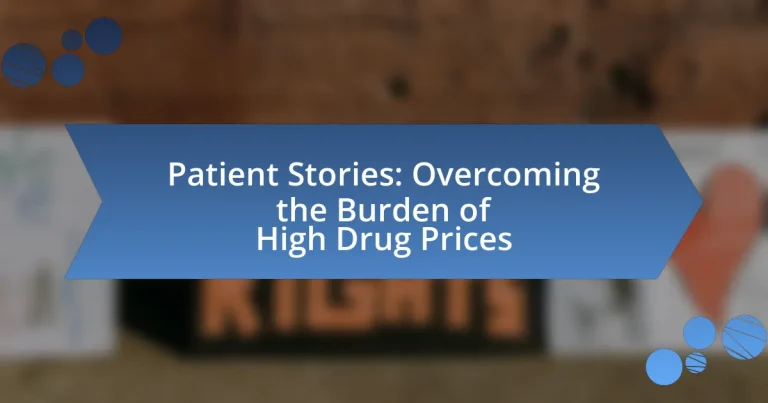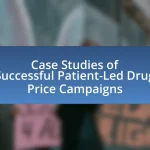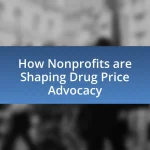The article focuses on the significant challenges patients face due to high drug prices, including financial strain, medication non-adherence, and limited access to necessary treatments. It highlights how high costs impact patient health outcomes and exacerbate health disparities, particularly among lower-income populations. Specific medications, such as insulin and EpiPens, are identified as being particularly affected by price increases. The article also discusses the emotional and financial burdens on patients, strategies they employ to manage costs, and the role of advocacy groups in pushing for lower drug prices. Additionally, it provides practical tips for patients to navigate the complexities of medication affordability.
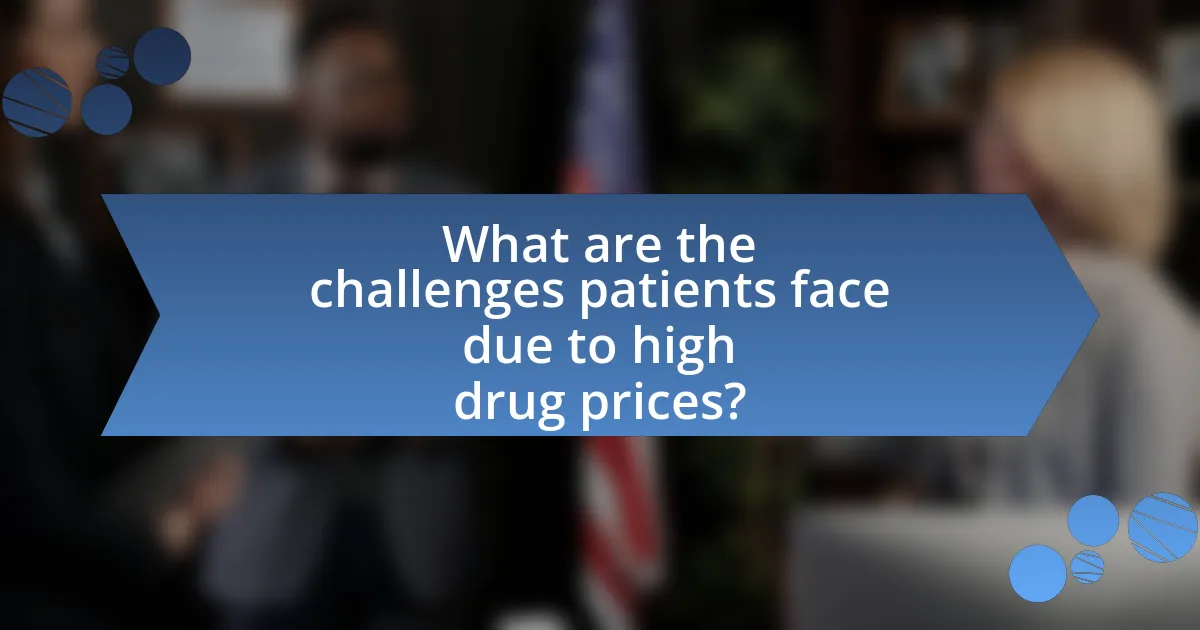
What are the challenges patients face due to high drug prices?
Patients face significant challenges due to high drug prices, primarily including financial strain, medication non-adherence, and limited access to necessary treatments. Financial strain occurs as patients may struggle to afford their prescriptions, leading to difficult choices between medication and other essential expenses. Medication non-adherence is prevalent, with studies indicating that nearly 25% of patients skip doses or do not fill prescriptions due to cost concerns. Limited access to necessary treatments arises when patients cannot afford medications, resulting in worsened health outcomes and increased long-term healthcare costs. These challenges highlight the critical impact of high drug prices on patient health and well-being.
How do high drug prices impact patient access to necessary medications?
High drug prices significantly limit patient access to necessary medications. When medications are priced beyond what patients can afford, many individuals either forgo treatment altogether or resort to dangerous alternatives, such as using expired medications or not adhering to prescribed dosages. According to a 2021 survey by the Kaiser Family Foundation, nearly one in four Americans reported not filling a prescription due to cost, highlighting the direct correlation between high prices and reduced access to essential treatments. This situation exacerbates health disparities, as lower-income populations are disproportionately affected, leading to worse health outcomes and increased healthcare costs in the long run.
What specific medications are most affected by high prices?
Insulin, EpiPens, and certain cancer medications are among the specific medications most affected by high prices. For instance, the price of insulin has increased significantly over the past decade, with some patients reporting costs exceeding $1,000 per month. Similarly, EpiPens, used for severe allergic reactions, have seen price hikes from around $100 for a two-pack in 2016 to over $600 in recent years. Cancer medications, such as imatinib (Gleevec), can cost upwards of $100,000 annually, placing a substantial financial burden on patients. These examples illustrate the critical issue of high drug prices impacting access to essential medications.
How do high drug prices affect patients’ health outcomes?
High drug prices negatively impact patients’ health outcomes by limiting their access to necessary medications. When patients cannot afford prescribed drugs, they may skip doses, delay treatment, or forgo medications altogether, leading to worsened health conditions. For instance, a study published in the Journal of the American Medical Association found that nearly 25% of patients reported not filling a prescription due to cost, which can result in increased hospitalizations and complications. Additionally, high drug prices contribute to medication non-adherence, which is associated with higher rates of morbidity and mortality.
Why do drug prices vary so significantly across different regions?
Drug prices vary significantly across different regions due to factors such as local economic conditions, regulatory environments, and market competition. For instance, in countries with stringent price controls, such as Canada, medications are often cheaper than in the United States, where pharmaceutical companies set prices based on market demand and profit margins. Additionally, variations in healthcare systems, insurance coverage, and the availability of generic alternatives further influence pricing. According to a 2021 report by the House of Representatives Ways and Means Committee, the U.S. pays on average four times more for prescription drugs than 11 other high-income countries, highlighting the impact of regional policies and market dynamics on drug costs.
What factors contribute to the pricing strategies of pharmaceutical companies?
Pharmaceutical companies’ pricing strategies are influenced by factors such as research and development costs, market competition, regulatory environment, and the perceived value of the drug. Research and development costs can exceed billions of dollars, as evidenced by a 2020 study from the Tufts Center for the Study of Drug Development, which reported that the average cost to develop a new drug is approximately $2.6 billion. Market competition affects pricing, as companies may lower prices to remain competitive or maintain high prices if they hold a patent. The regulatory environment also plays a crucial role, with government policies impacting pricing strategies through price controls or reimbursement rates. Lastly, the perceived value of a drug, determined by its effectiveness and uniqueness, can justify higher prices, as seen with specialty drugs that target specific conditions.
How do insurance policies influence drug pricing for patients?
Insurance policies significantly influence drug pricing for patients by determining coverage levels, copayments, and formulary placements. These policies dictate which medications are covered, how much patients pay out-of-pocket, and the overall accessibility of drugs. For instance, a study by the Kaiser Family Foundation found that patients with high-deductible health plans often face higher costs for medications, leading to reduced adherence to prescribed treatments. Additionally, insurance companies negotiate prices with pharmaceutical manufacturers, which can result in lower costs for covered drugs but may also lead to higher prices for those not on the formulary. Thus, the structure of insurance policies directly impacts the affordability and accessibility of medications for patients.
What emotional and financial burdens do patients experience?
Patients experience significant emotional and financial burdens due to high drug prices. Emotionally, patients often face anxiety, stress, and feelings of helplessness when they cannot afford necessary medications, leading to potential deterioration in mental health. Financially, the high cost of medications can result in substantial out-of-pocket expenses, which may lead to debt, financial strain, or even bankruptcy. According to a survey by the Kaiser Family Foundation, nearly 25% of Americans reported not filling a prescription due to cost, highlighting the direct impact of drug prices on patients’ financial well-being.
How do high drug prices affect patients’ mental health?
High drug prices negatively impact patients’ mental health by increasing stress and anxiety related to financial burdens. Patients often experience feelings of helplessness and depression when they cannot afford necessary medications, leading to a decline in overall well-being. Research indicates that individuals facing high out-of-pocket costs for prescriptions report higher levels of psychological distress, with studies showing that 29% of patients with chronic conditions experience anxiety due to medication costs. This financial strain can exacerbate existing mental health issues and hinder treatment adherence, further complicating their health outcomes.
What are the financial implications for patients struggling to afford medications?
Patients struggling to afford medications face significant financial implications, including increased out-of-pocket expenses, potential debt accumulation, and the risk of foregoing necessary treatments. These financial burdens can lead to adverse health outcomes, as patients may skip doses or not fill prescriptions due to cost concerns. According to a 2021 survey by the Kaiser Family Foundation, nearly 29% of adults reported not taking their medications as prescribed due to cost, highlighting the direct correlation between medication affordability and patient adherence. Additionally, the inability to afford medications can result in higher long-term healthcare costs, as untreated conditions may lead to complications requiring more expensive interventions.
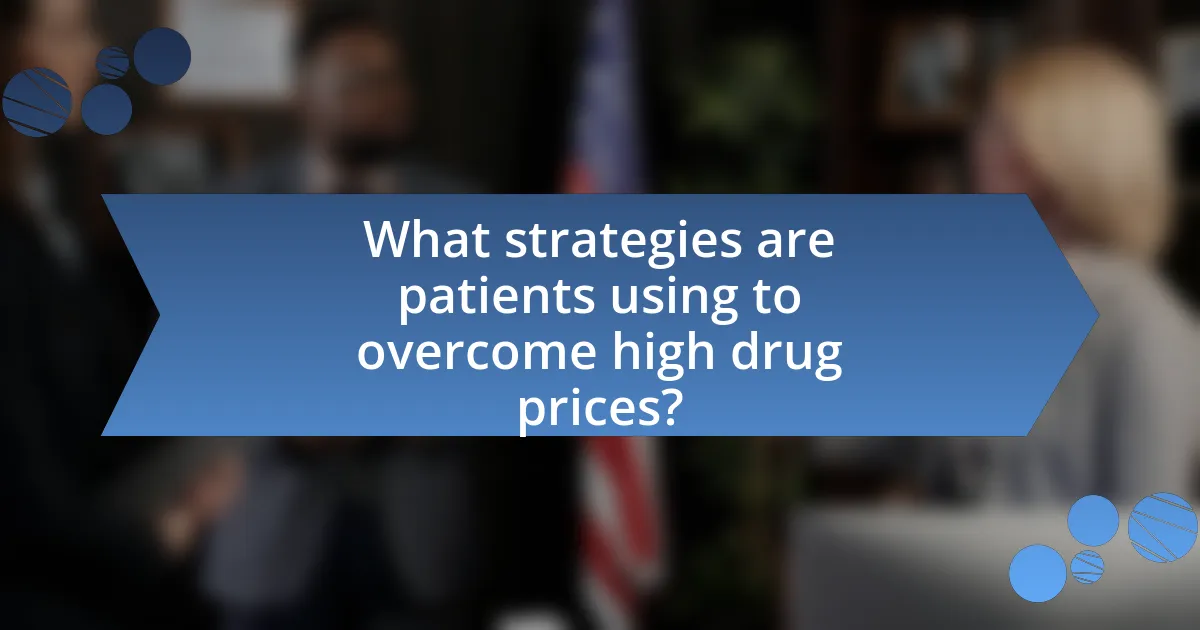
What strategies are patients using to overcome high drug prices?
Patients are using various strategies to overcome high drug prices, including seeking generic alternatives, utilizing patient assistance programs, and negotiating prices with pharmacies. For instance, many patients opt for generic medications, which can be significantly cheaper than brand-name drugs, often saving them up to 80% on their prescriptions. Additionally, organizations like the Partnership for Prescription Assistance provide resources that help patients access medications at reduced costs or for free, demonstrating the effectiveness of patient assistance programs. Furthermore, some patients negotiate directly with pharmacies or use discount cards, which can lead to lower out-of-pocket expenses. These strategies collectively illustrate how patients actively manage the financial burden of high drug prices.
How are patients advocating for lower drug prices?
Patients are advocating for lower drug prices through grassroots movements, social media campaigns, and direct engagement with policymakers. These efforts include organizing protests, sharing personal stories of financial hardship due to high medication costs, and utilizing platforms like Twitter and Facebook to raise awareness and mobilize support. For instance, organizations such as Patients for Affordable Drugs have been instrumental in amplifying patient voices, leading to increased public discourse on drug pricing and influencing legislative proposals aimed at reducing costs.
What role do patient advocacy groups play in this movement?
Patient advocacy groups play a crucial role in the movement against high drug prices by amplifying the voices of patients and influencing policy changes. These organizations mobilize individuals affected by high medication costs, providing them with resources and support to share their experiences, which helps to raise public awareness and drive legislative action. For instance, groups like Patients for Affordable Drugs have successfully lobbied for drug pricing reforms, demonstrating the impact of collective patient narratives on policymakers. Their efforts often lead to increased transparency in drug pricing and push for regulations that aim to lower costs, thereby directly addressing the financial burdens faced by patients.
How can patients effectively communicate their needs to policymakers?
Patients can effectively communicate their needs to policymakers by sharing personal stories that illustrate the impact of high drug prices on their lives. Personal narratives provide emotional context and highlight specific challenges, making the issue more relatable and urgent for policymakers. Research shows that storytelling can significantly influence decision-makers; for instance, a study published in the Journal of Health Communication found that narratives can enhance understanding and empathy among policymakers. By presenting clear, concise, and compelling accounts of their experiences, patients can advocate for policy changes that address the financial burdens of medication.
What alternative options are available for patients facing high drug costs?
Patients facing high drug costs have several alternative options available to manage their expenses. These options include utilizing patient assistance programs offered by pharmaceutical companies, which provide medications at reduced costs or for free to eligible individuals. Additionally, patients can explore generic drug alternatives, which are often significantly cheaper than brand-name medications. Another option is to use discount cards or coupons that can lower the price of prescriptions at pharmacies. Furthermore, patients may consider discussing their situation with healthcare providers to find lower-cost treatment alternatives or to receive samples. Research indicates that nearly 30% of patients have reported using these strategies to alleviate the financial burden of medications.
How do generic drugs and biosimilars provide relief?
Generic drugs and biosimilars provide relief by offering lower-cost alternatives to brand-name medications, making essential treatments more accessible to patients. These alternatives are chemically identical or highly similar to their branded counterparts, ensuring comparable efficacy and safety. For instance, the introduction of generic drugs has been shown to reduce medication costs by an average of 30% to 80%, significantly alleviating the financial burden on patients. Additionally, biosimilars, which are designed to replicate biologic drugs, can lead to savings of up to 50% compared to the original biologics, further enhancing affordability for patients requiring complex therapies.
What resources are available for patients seeking financial assistance?
Patients seeking financial assistance can access various resources, including government programs, non-profit organizations, and pharmaceutical company assistance programs. Government programs such as Medicaid and Medicare provide financial support for eligible individuals, while organizations like the Patient Advocate Foundation and NeedyMeds offer assistance with medical bills and prescription costs. Additionally, many pharmaceutical companies have patient assistance programs that help cover the cost of medications for those who qualify based on income and need. These resources collectively aim to alleviate the financial burden associated with high drug prices, ensuring that patients can access necessary treatments.
How can patients leverage technology to manage drug costs?
Patients can leverage technology to manage drug costs by utilizing online tools and apps that compare prices, access discounts, and facilitate communication with healthcare providers. For instance, platforms like GoodRx allow patients to search for the lowest prices on medications at local pharmacies, often revealing significant savings. Additionally, telehealth services enable patients to consult with healthcare professionals remotely, which can reduce costs associated with in-person visits and streamline the process of obtaining prescriptions. According to a 2021 study published in the Journal of Medical Internet Research, patients who used digital health tools reported a 20% reduction in out-of-pocket expenses for medications.
What apps and websites help patients find affordable medications?
Apps and websites that help patients find affordable medications include GoodRx, RxSaver, and Blink Health. GoodRx provides price comparisons for prescriptions at various pharmacies, allowing users to find the lowest prices available in their area. RxSaver offers similar services, enabling users to search for discounts and coupons for medications. Blink Health allows patients to purchase medications online at discounted rates and pick them up at local pharmacies. These platforms have been shown to significantly reduce out-of-pocket costs for patients, with GoodRx reporting that users save an average of 80% on their prescriptions.
How can telemedicine reduce overall healthcare costs for patients?
Telemedicine can reduce overall healthcare costs for patients by minimizing expenses associated with in-person visits, such as travel, time off work, and facility fees. A study published in the Journal of Medical Internet Research found that telemedicine consultations can be up to 50% less expensive than traditional office visits, primarily due to reduced overhead costs for healthcare providers and the elimination of transportation expenses for patients. Additionally, telemedicine facilitates quicker access to care, which can lead to earlier diagnosis and treatment, ultimately reducing the need for more expensive emergency care or hospitalizations.
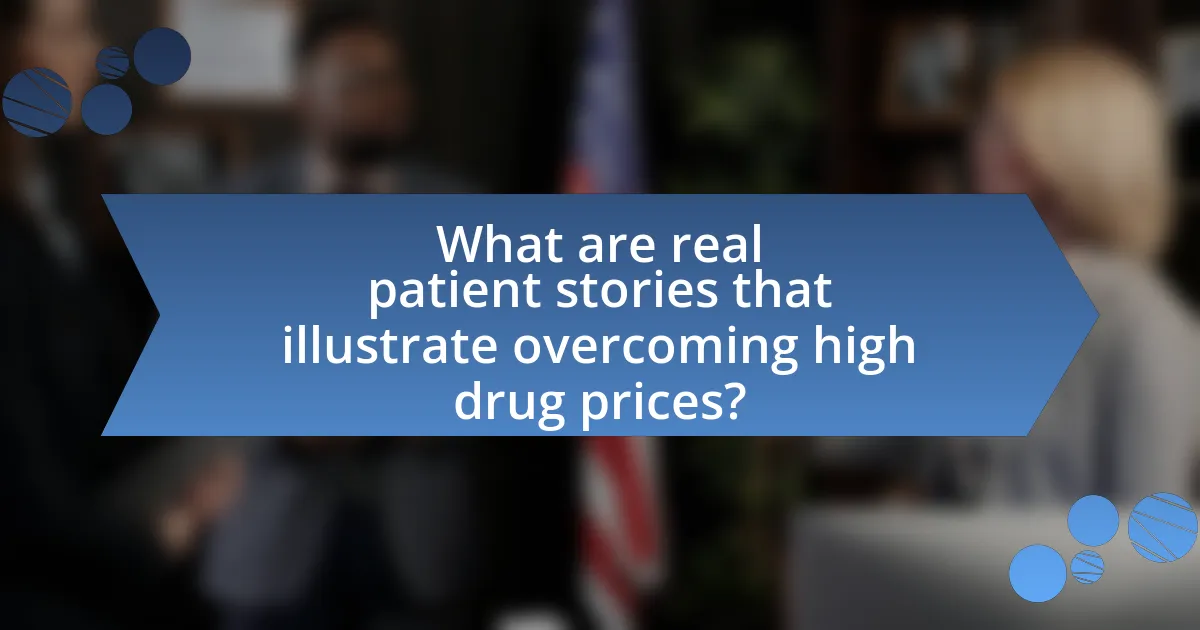
What are real patient stories that illustrate overcoming high drug prices?
Real patient stories that illustrate overcoming high drug prices include the experience of a woman named Sarah, who faced a monthly cost of $2,000 for her insulin. After researching options, she discovered a patient assistance program offered by the manufacturer, which reduced her cost to $25 per month. Another example is John, who needed a cancer medication priced at $10,000. He worked with his healthcare provider to apply for financial assistance through a nonprofit organization, ultimately receiving the medication at no cost. These stories highlight how patients can navigate high drug prices through assistance programs and advocacy.
How have individual patients successfully navigated high drug costs?
Individual patients have successfully navigated high drug costs by utilizing various strategies such as seeking financial assistance programs, negotiating prices, and exploring generic alternatives. For instance, many patients have accessed manufacturer-sponsored patient assistance programs that provide medications at reduced costs or for free, significantly alleviating their financial burden. Additionally, patients have reported negotiating with pharmacies for lower prices or using discount cards, which can lead to substantial savings. Research indicates that the use of generic drugs can reduce costs by up to 80% compared to brand-name medications, further demonstrating effective cost management strategies employed by patients.
What specific actions did patients take to afford their medications?
Patients took several specific actions to afford their medications, including seeking financial assistance programs, negotiating prices with pharmacies, and utilizing generic alternatives. For instance, many patients applied for manufacturer-sponsored patient assistance programs, which provide medications at reduced costs or for free to those who qualify based on income. Additionally, patients often contacted pharmacies to inquire about discounts or price matching, which can significantly lower out-of-pocket expenses. Furthermore, opting for generic versions of medications, which are typically less expensive than brand-name drugs, allowed patients to manage their costs more effectively. These actions demonstrate proactive strategies employed by patients to mitigate the financial burden of high drug prices.
What lessons can be learned from these patient experiences?
Lessons learned from patient experiences with high drug prices include the importance of advocacy for affordable medication and the need for transparent pricing in healthcare. Patients often report feeling overwhelmed by the financial burden of prescriptions, which highlights the necessity for systemic changes in drug pricing policies. For instance, a study published in the Journal of the American Medical Association found that nearly 25% of patients skip doses or do not fill prescriptions due to cost concerns, underscoring the critical impact of drug prices on patient adherence and health outcomes. These experiences emphasize the need for healthcare providers to engage in discussions about cost-effective treatment options and for policymakers to implement regulations that promote fair pricing practices.
What role do community support and shared experiences play?
Community support and shared experiences play a crucial role in helping patients navigate the challenges of high drug prices. This support system fosters a sense of belonging and reduces feelings of isolation, which can be particularly important for individuals facing financial burdens related to healthcare. Research indicates that patients who engage with supportive communities often report improved emotional well-being and increased resilience in managing their health conditions. For instance, a study published in the Journal of Health Psychology found that shared experiences among patients can lead to better coping strategies and enhanced motivation to seek necessary treatments, ultimately contributing to better health outcomes.
How can support groups help patients cope with high drug prices?
Support groups can help patients cope with high drug prices by providing emotional support, sharing resources, and facilitating access to financial assistance programs. These groups create a community where individuals can discuss their experiences and strategies for managing costs, which can alleviate feelings of isolation and stress. Research indicates that patients who participate in support groups report improved coping skills and a better understanding of available financial resources, such as patient assistance programs offered by pharmaceutical companies, non-profit organizations, and government initiatives. This collective knowledge empowers patients to make informed decisions about their treatment options and seek help in navigating the complexities of drug pricing.
What impact do shared stories have on raising awareness about drug pricing issues?
Shared stories significantly raise awareness about drug pricing issues by personalizing the impact of high costs on individuals and families. These narratives humanize the statistics, illustrating the real-life struggles faced by patients who cannot afford necessary medications. For instance, a study published in the Journal of Health Economics found that personal accounts of financial hardship related to drug costs can lead to increased public support for policy changes aimed at reducing prices. By sharing their experiences, individuals can mobilize community action and influence policymakers, thereby fostering a broader understanding of the urgency surrounding drug pricing reform.
What practical tips can patients apply to manage their medication costs?
Patients can manage their medication costs by utilizing generic medications, which are often significantly cheaper than brand-name drugs. Research indicates that generic drugs can cost up to 80% less than their branded counterparts, providing substantial savings for patients. Additionally, patients should explore patient assistance programs offered by pharmaceutical companies, which can provide medications at reduced costs or even for free based on income eligibility. Furthermore, using discount cards or apps can help patients find lower prices at local pharmacies, as these tools often provide access to negotiated rates. Lastly, discussing medication options with healthcare providers can lead to alternative treatments that are more affordable, ensuring patients receive necessary care without financial strain.
